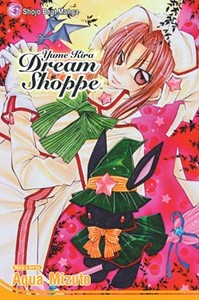Review
by Theron Martin,Yume Kira Dream Shoppe
GN 1
| Synopsis: |  |
||
The mystical Yume Kira Dream Shoppe flies through the dusk sky, seeking out wishes floating on the wind. Its proprietor Rin can grant any wish, no matter its nature or source, in exchange for something dear to the wisher. Spun here are four such tales of wishes granted involving matters of courage, capability, and the heart. Hazuki, the spirit of a tree unable to bloom, seeks human form to express gratitude to the hospitalized young composer whose music has inspired the tree to bloom again. Alpha, a plushie rabbit, seeks mobility and voice to communicate with his beloved owner Noa and help her overcome her shyness in approaching the boy she likes. Miki, an injured amnesiac girl, seeks to learn of the past she's forgotten, even if she is unable to change it. Koyoru, a shy girl, seeks to be closer to handsome classmate Eito, even if only in a dream. |
|||
| Review: | |||
Another title in Viz Media's Shojo Beat Manga label, Yume Kira Dream Shoppe is a compilation of four stand-alone stories published in English in Shojo Beat during May-August 2007. Though manga-ka Aqua Mizuto originally intended YKDS to be just a one-shot project, she was inspired to create additional material by fan reaction to “The Sound That Brings Blossoms,” the first of the four stories. It is not hard to understand why the story generated such a reaction, as it tells the kind of simple, heartfelt, earnest story of love virtually guaranteed to ingratiate itself to the target audience of teenage girls. Even more impressively, one does not have to be a teenage girl to appreciate it. In a sense that's unfortunate, because the collected volume does nothing, at first glance, to convince a potential reader that it isn't only chock full of common shojo fare. The style and coloring of the cover art virtually screams “shojo,” and it does feature a talking plushie as its recurring supporting character. The interior artistic style also does nothing that has not been seen before in innumerable other shojo titles. It is only once a reader starts paying attention to the content and pacing of the initial story that its ability to transcend its origins becomes apparent. So honest is its feel, and so lacking in pretentiousness is its nature, that one cannot help but be swept up by its graceful flow. Some may even find it to be an emotional read despite a bit of levity. The second story, “Beyond the Redeye,” explains the origin of Alpha and how he came to be Rin's assistant, in the process doing quite a fair job of establishing and spinning a tale about a girl so isolated by her shyness that she lacks friends beyond her precious stuffed bunny. The “too shy to confess her feelings” theme returns in “The Labyrinth Wave of Dreams,” the much more standard shojo story which closes out the volume. In between “A Promise to a Grain of Time” tells a too-brief and rushed story about how dissatisfaction with the strength of a relationship leads to calamity and amnesia. Although it does partly achieve its intended degree of poignancy and is still a good story overall, it might have worked better had it been at least half again as long. The only common linking between the stories is the Dream Shoppe, Alpha, and the shopkeeper Rin, whose behavior, dress, and androgynous look leave the correct gender in doubt. (An impression which, according to Mizuto's notes, was intentional.) Rin never demonstrates much personality beyond his regular dramatic flair and perturbed reaction to the antics of the crew of the Silver Queen in the fourth story, but he/she is more a host and facilitator for each story than an actual participant in them. Alpha, meanwhile, fills the role of the comedy sidekick. Mizuto's male character designs use the lanky, long-necked, pretty-faced characteristics so typical of shojo manga styles. Female character designs also have common long-neck, pointy-chin features but distinguish themselves a bit more, especially Hazuki with her more formal outfit and regular chibi flashes. (Chibi versions of all the heroines can be seen in color on the back cover, however.) The one true weakness here is the very plain way Mizuto draws stocking-covered legs, where the lack of any effort to depict a knee makes them look odd. Flower effects abound, and background art, when present, shows sufficient detail. The patterning of the shading sometimes lack effectiveness, but those defects are not readily noticeable. Viz Media's release of the title begins with a product listing of the key transformational items in each story and closes with author comments about each chapter and in general, a one-page short about Alpha, and a very brief bio page about Mizuto. Three of the stories also have additional sidebar author comments. Sound effects are invariably translated, but it does look like an effort was made to retain the shape and positioning of the original Japanese versions. The glossy cover uses a pink-dominated color scheme sure to discourage non-shojo fans. The quality of the stories gradually decreases as the volume progresses, but nice execution of some fine ideas, and a good depth of feel on a couple of the stories, warrants giving the volume a look. Fans of shojo manga should adore it, while even non-fans may find at least the first story or two to be worthwhile. |
|
The views and opinions expressed in this article are solely those of the author(s) and do not necessarily represent the views of Anime News Network, its employees, owners, or sponsors.
|
| Grade: | |||
Overall : B+
Story : B+
Art : B-
+ “The Sound That Brings Blossoms” |
|||
| discuss this in the forum (5 posts) | | |||
| Production Info: | ||
|
Full encyclopedia details about Release information about |
||